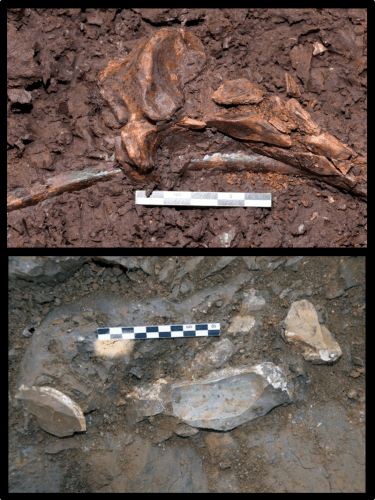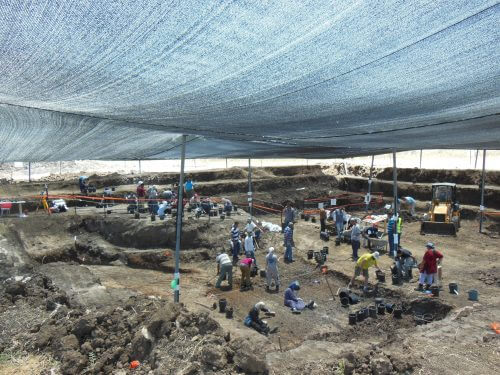Excavation in the Ein Kashish area in the Jezreel Valley has revealed findings in recent years that disprove the assertion that the settlement system included cave sites with a diverse range of activities, and sites open for shorter use and a limited range of activities. A new article published in the scientific journal "PLOS One" by researchers from the Hebrew University and the Antiquities Authority proves that early man knew how to use open environments over time for diverse needs

The Neanderthal man who lived in the area of Ein Kashish in the Jezreel Valley used his environment over time in the same location in the open landscape in order to maintain a large range of activities - this was revealed in a scientific article recently published in the scientific journal "PLOS One", describing the results of the excavation at the site of Ein Kashish, which is located on the bank of the Kishon River , in a study carried out by a team of Israeli researchers from the Hebrew University and the Antiquities Authority and researchers from Germany. This is another publication regarding research work conducted in recent years in the Ein Kasish area, where skeletons of the Neanderthal man (known as the "cave man") were found. ("Cavemen"? Not necessarily).
The information that exists today regarding the people who lived in the Levant in prehistoric times is taken from research and excavations conducted in the caves. Open sites (kators) have been studied less in our region, although it is clear that man during these periods stayed both in caves and in kator sites. The excavation at Ein Kashish revealed an open site that can provide a lot of complementary information about the settlement patterns of the period.
The site was used for a variety of activities including hunting. While in the caves that were inhabited at that time by the Neanderthals there is only little evidence of the exploitation of large animals, in Ein Kashish many of their remains were found. The animal bones found in the excavation indicate the utilization of a wide variety of animals from several habitats around the site. Another activity that took place at the site is the chiselling of flint tools. The study of the lithic remains points to the creation of a variety of tools intended for diverse activities, in contrast to short-lived kator sites where the chiseling is aimed at a specific activity such as hunting.
The excavation at the site was led by Prof. Arala Hobars from the Institute of Archeology at the Hebrew University and Dr. Omri Barzilai from the Antiquities Authority. The team of experts was headed by Dr. Ravid Eckstein from the Institute of Archeology at the Hebrew University and Dr. Ariel Malinsky-Buller from the Archaeological Research Center and Museum for Human Behavioral Evolution, MONREPOS in Germany, who analyzed the findings from the site in their environmental, climatic and cultural aspects.
The site dates to the time period between 71 and 54 thousand years, the prehistoric period known as the 'Middle Paleolithic'. The duration of the settlement there was probably shorter than the range of these years. The Middle Paleolithic period is characterized in our region by the sites where the remains of the Neanderthal man were found (Kabara Cave, Amud Cave) and also by the sites where the remains of Homo sapiens were found (Masalia, Kaptza, Sakhol and Manot caves). While it is clear that Neanderthals lived both in caves and at sites, for the first time at this site it is possible to link between several different settlements over time and skeletal findings of Neanderthal man. Evidence of three items was found on the site - a fragment of a skull, a tooth, and another item including several leg bones and a vertebra. Two of the individuals were definitely identified as Neanderthals.

The uniqueness of the Ein Kashish site is the large excavation area (about 670 square meters out of the estimated area of the site, about 1300 square meters) compared to other Kator sites of the same period. "The archaeological dig in Ein Kashish created for the researchers a rare opportunity to examine diverse aspects of the lives of the Neanderthals in the open landscape, and a more complete understanding of the way the ancient land was used, the way the ancient people behaved on the surface of the site and understanding the changes over time between the different settlements," states D. R. Eckstein. The settlement on the site was in the Kishon river plain, where alluvium and pebbles that came from both Carmel and the Jezreel valley were deposited.
A number of unique finds were found on the site, including a Yachmor horn, which is a relatively rare find in all sites of the same period. The horn may have been used as a soft mace in the chiseling process of the flint tools, especially for tools that were produced using a technique that required a high degree of skill and precision. Another unique find is a sequence of flint items that were hewn one after the other and abandoned in the same place (photo is in the article), clearly showing the sequence of actions of the ancient stonemasons. These items were preserved without displacement despite the dynamic processes of deposition and removal of alluvial material originating both from the Kishon and from the ancient Kashish stream.
This sequence, and the assemblage of flint tools as a whole (12,000 items) allow researchers a glimpse into the mason's mind. Finding the items of the same chipping sequence in the same place allows researchers to reconstruct the chipping sequence, and to understand what the chipping goals were, which items they wanted to produce and which methods they chose to produce them. Other unique finds that do not exist in sites from that period are small lumps of dyes (pigments), a large seashell brought from the beach (at a distance of about 10 km), and of course the remains of Neanderthal man.
Ein Kashish is an example of a Kator site dating to the end of the Middle Paleolithic where they returned to the same location again and again in order to maintain a large range of activities. The excavations point to a stable settlement model over time. These findings are particularly interesting in light of the fact that at the end of the period the Neanderthal man disappeared from the area. The research findings further strengthen the question marks surrounding the reason for the disappearance of the Neanderthals from our region.
More of the topic in Hayadan:
